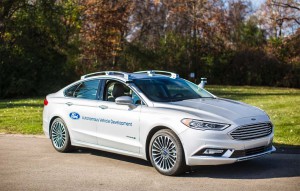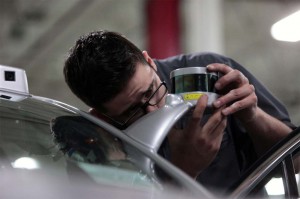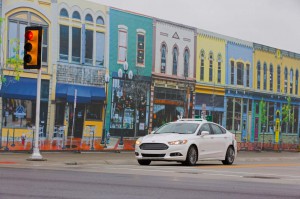
Ford is tripling the size of its autonomous fleet in 2017 as it plans to make an autonomous vehicle ready for the public by 2021.
With a goal of launching its first completely driverless cars by 2021, Ford Motor Co. will triple the size of its test fleet next year, the automaker announced on Wednesday.
The automaker offered a sneak peek at the next-generation Fusion Hybrid sedans it will use in its test fleet. Currently, there are 30 of those vehicles in operation in Arizona, California and Michigan. The fleet will reach 90 vehicles by the end of 2017.
“The new vehicle uses the current Ford autonomous vehicle platform, but ups the processing power with new computer hardware,” Ford said in a statement. “Electrical controls are closer to production-ready, and adjustments to the sensor technology, including placement, allow the car to better see what’s around it.”
One of the biggest changes will come in the form of updated LiDAR sensors – or more accurately, the high-definition, laser-based devices will shrink in size dramatically. Earlier versions were about the size of a softball. The revised devices are no bigger than a hockey puck. And only two are needed, rather than the four on the older Fusion Hybrids.
LiDAR is used to create a detailed, three-dimensional image of the world, that data “fused” with information from onboard radar and cameras to help the vehicle navigate the road safely.
As with the current generation test vehicles, the new sedans will still require a human “operator” to remain behind the wheel, ready to assume control instantly in an emergency. That is the path that most manufacturers are taking as they prepare to put the first fully autonomous vehicles on the road by sometime early in the coming decade.
(Lincoln planning to reveal next wave in product assault. For more, Click Here.)
Ford global product development director Raj Nair announced earlier this year that the automaker intends to go a step further, arguing that requiring a human to be ready to take over instantly, even after hours of doing nothing, is a potential recipe for disaster.
“We don’t think the path to true autonomy is through a step-by-step, incremental process,” Nair told TheDetroitBureau.com during an August interview. Instead, the automaker wants to go with a completely driverless vehicle that may not even be equipped with conventional controls such as a steering wheel and pedals.
But going that extra step adds a number of additional challenges beyond what autonomous vehicles already post. “Building a car that will not be controlled by a human driver is completely different from designing a conventional vehicle,” Chris Brewer, chief program engineer for Ford’s Autonomous Vehicle Development, wrote in a blog post on Ford’s website. “This raises a whole new set of questions for our autonomous vehicle engineering team.”
(Click Here for spy shots of the all-aluminum Ford Expedition.)
The new Fusion models will be, in industry lingo, Level 3 capable, meaning they will continue to have a trained operator at the ready behind conventional vehicle controls. Ford hasn’t said when it might introduce the first fully driverless test vehicles. Michigan law was recently updated to allow testing these Level 4 vehicles on public roads.
Ford is also testing its autonomous systems on a number of closed tracks, including MCity, a facility operated by the University of Michigan near Ann Arbor.
The second-largest automaker said it expects to have its driverless vehicles in production by 2021, but only for ride-sharing and delivery fleets. As costs drop, Nair said, the goal will be to have versions of the technology available for retail buyers later in the decade.
(To see more about Ford’s plans for its $2 billion in new debt, Click Here.)
Virtually every major automaker is now testing autonomous technology, but Ford is unique in saying it wants to go straight to fully driverless models. Waymo, the renamed Google autonomous vehicle unit, has also said it plans to begin testing driverless vehicles, though it has not outlined plans for production.


